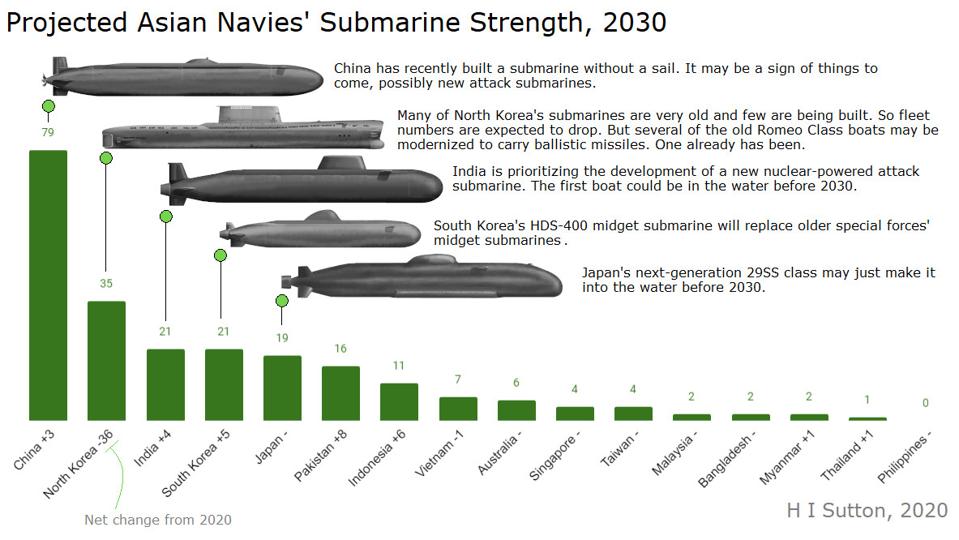191 views
Asian Submarine Forces Forecast For 2030
Submarines are the hot asset among Asian countries right now. Today there are ~239 in service with the region’s navies. Almost every navy is acquiring new types. If we look ahead 10 years the submarine landscape in the region will be very different.
The total number of submarines will likely drop to around 220. More on why that is later. But this headline drop in numbers hides the greater trend which is one of expansion and modernization of submarine forces.
China has the largest submarine fleet in the world. I project a small increase from ~75 to 79 boats. Within this expect new classes of ballistic missile submarines, attack submarines and conventional submarines. There is also a small but growing fleet of ‘oddball’ types, including the enigmatic ‘sailless’ design.
Today In: Business
India is renewing its fleet and also adding new nuclear-powered ballistic missile submarines. These put it in an elite club among world navies. In overall capability terms it is ahead of all other navies in Asia except China. Also before 2030, it’s just possible that the first indigenous nuclear-powered attack submarine could be in the water. The new SSBNs increase the count by 4 hulls, while other new submarines will likely replace existing boats on a 1:1 basis.
South Korea has a strong navy including a sizable fleet of conventional submarines. The first of 9 indigenous Dosan Ahn Changho class submarine was launched in 2018. This will likely increase overall submarine strength by 2030, overtaking Japan. These are the first conventional submarine in the world with a vertical launch system (VLS) for cruise missiles.
Japan has a reputation for building cutting edge conventional submarines. They are going into a period without new construction however while the next-generation 29SS design is finalized. It is just possible that one might be in the water before the end of the decade.
Pakistan is increasing it’s fleet with 8 Chinese designed Type-039B submarines. Indonesia also plans to increase its fleet by 5 boats although this seems far from certain. But there is a possibility that a small indigenous submarine might be built. Another country which plans a massive force increase is Australia, from 6 to 12 submarines. But the first of the new Attack Class boats won’t be delivered until the 2030s so don’t count in this forecast.
Myanmar and Thailand are both likely to increase their small submarine fleets by a single hull each. These tiny numbers are a big deal to the navies involved and are part of a wider trend for small navies to acquire submarines.
It’s not all increases. Vietnam will likely drop one hull as North Korean midget submarines are retired, replaced by a single locally designed boat.
So back to the overall numbers, why will the total number of submarines drop from 239 to 220? The answer is North Korea. Currently the hermit kingdom operates a massive fleet of submarines, around 71 boats. But most of these are small ‘midget submarines’ and the larger ones are very dated. Many will not make it to the end of this decade. I project a drop of around 50%, which is driving the overall numbers down. Of note, several more ballistic missile submarines will likely be in service. These will most likely be conversions of older boats.
So while the overall number of submarines in Asian navies will drop by about 20, the real trend is modernization and expansion.




Ingen kommentarer:
Legg inn en kommentar
Merk: Bare medlemmer av denne bloggen kan legge inn en kommentar.